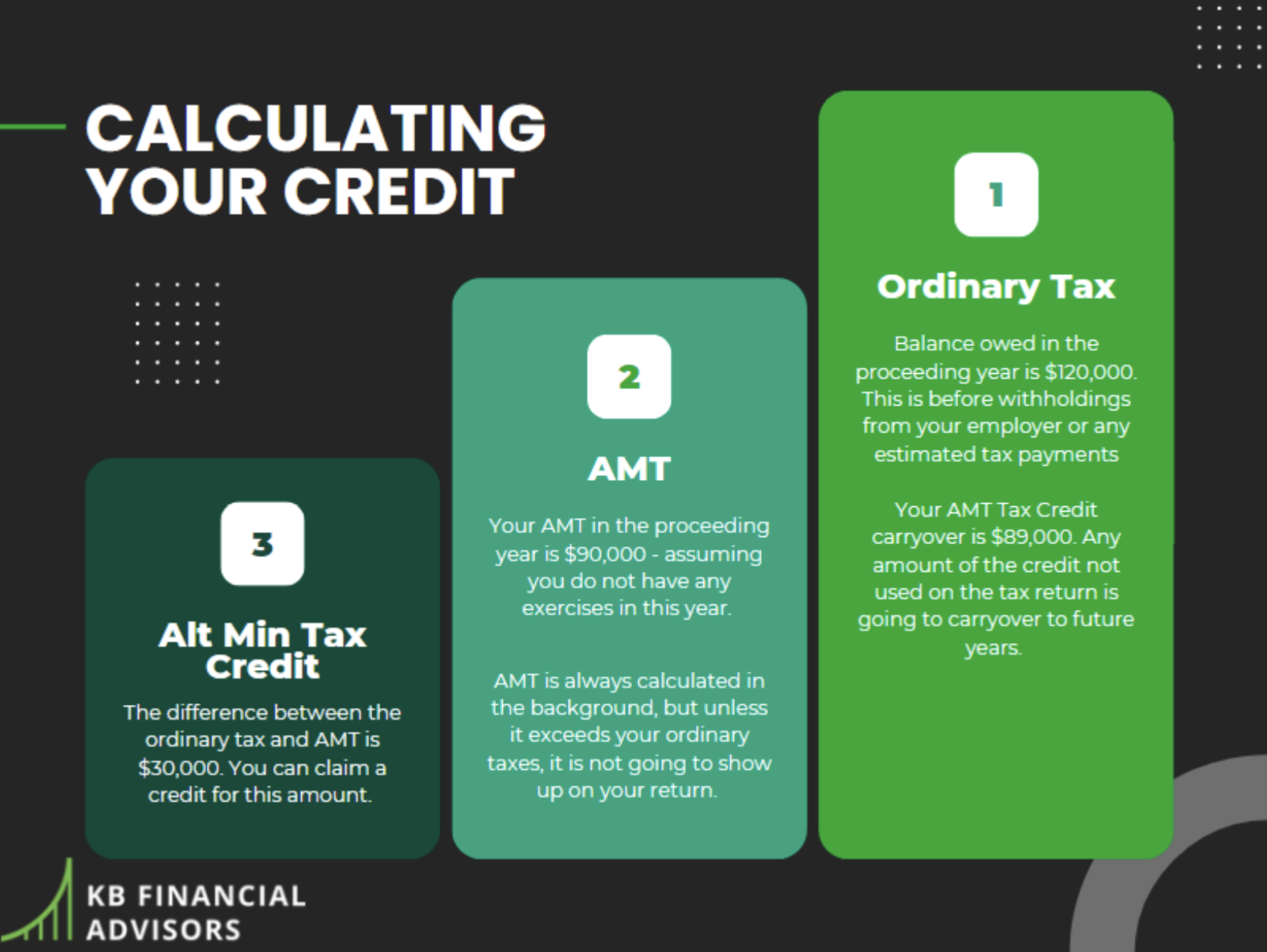If you qualify for the alternative minimum tax credit after exercising ISOs, here’s how to receive the tax reduction faster.
If you’ve had to pay the alternative minimum tax (AMT) after exercising your incentive stock options (ISOs), you understand how much of a nuisance it can be.
However, the upside of paying the AMT is the AMT credit, otherwise known as a dollar-for-dollar reduction for having paid the alternative minimum tax in previous years. If you play your cards right, you can even accelerate this credit, but more on that after we cover some basics.
How do you qualify for the AMT credit?
Before you can benefit from the AMT credit, you need to qualify for it. Simply put, you must have paid alternative minimum tax in previous years to qualify for the credit.
The mechanics of the previous year’s alternative minimum tax are that on the date of exercise, the value of the stock, less your cost to purchase, is considered an addition to this special tax base.
Here’s an example:
- You exercise and hold your shares on January 30
- The value of the shares on exercise is $58.98
- Your exercise price is $1.65
- The difference (also known as the bargain element) is $57.33
- You exercise 10,500 shares
- Your adjustment is $57.33 x 10,500 shares = $601,965
If you sell your shares within one year of exercising, alternative minimum tax doesn’t apply. That’s because this tax is subject to your ordinary tax rates. AMT rates fall somewhere between 26 and 28%, which is likely less than your ordinary tax rate. For purposes of this discussion, let’s say you end up holding the shares and pay $89,000 in AMT for exercising them.
The downside is you’re on the hook for those taxes even though you might have no liquidity from exercising the shares. This means you’d have to source cash from elsewhere to pay the tax. The silver lining to this sticky situation is that the tax becomes a credit called the minimum tax credit (MTC). Though it’s officially called the minimum tax credit, you’ll often hear folks referring to it as the AMT credit, hence the name of this blog post. These two terms are one and the same.
How does the AMT credit work?
Continuing on with the example from above, you’ve now paid your alternative minimum tax of $89,000, which is translated on your following year’s tax return as an AMT credit of $89,000. This credit only reduces your ordinary taxes and is not refundable. In other words, the AMT credit alone will not generate a refund, but it will reduce any applicable taxes you may have owed.
AMT exists in all fiscal years. However, it only shows up on your tax return if it’s triggered and is in excess of your ordinary taxes. The difference between your ordinary tax balance and alternative minimum tax balance is the amount that’s eligible for a credit. Any portion used will reduce your credit, but the remaining amount will carry over to the preceding year.
Here’s an example of the AMT credit in action:
4 ways to accelerate your AMT credit
Accelerating your alternative minimum tax credit means receiving your credit sooner. This curtails the amount of time you deal with an AMT-induced cash flow issue.
The simplest way to accelerate your AMT credit is by creating a larger gap between your ordinary tax and the alternative minimum tax.
Here are four tactics to widening that gap:
1. Include the correct AMT basis when you sell your ISOs
Under ordinary taxes, your basis is what you paid for them. But under the AMT base, the basis per share is actually the fair market value at exercise. This means you might have a large gain under the ordinary tax base but you’ll likely have a smaller gain on AMT. The difference between the two is entered as a negative adjustment on the AMT base. This creates a larger gap between the two tax bases, allowing you to claim more of your AMT credit.
Additionally, when you select shares to sell, the shares that have a higher fair market value at exercise will create a larger gap under this thought process. So, you can further reduce the AMT base by evaluating your inventory of shares exercised for those with the larger fair market value. Assuming you have a credit, this strategy will allow you to claim more of the credit during a year in which you sell shares from your inventory.
2. If you plan to donate, do so strategically
If you want to contribute some of the shares you previously exercised to a donor-advised fund, you’ll get the best bang for your buck by contributing highly appreciated stocks with a low cost basis. This is applicable for ordinary taxes, but when considering ISOs in particular, there’s another element to be mindful of: the fair market value of the options at the time of exercise. Preserve your inventory of higher fair market value on exercised shares. The reason being that when you sell shares later on, you want to reduce your AMT tax base as much as possible to claim more of your credit.
Here’s a breakdown of this three-fold method:
- You avoid capital gains on your highly appreciated stock
- You get a donation value at the current fair market value
- You preserve your high AMT basis stocks for future sales
3. Exercise your options while avoiding AMT that year
This is for if you know you’re going to exercise your options this year.Exercising can be dependent on factors including your feelings about the company and expiring options. Either way, you can sell some of your long-term holdings to make room to exercise without incurring AMT that year. Alternatively, you can exercise the options, sell the shares, and claim a portion of your credit.
Here’s an example:
- You exercise 5,000 shares, creating an AMT adjustment
- The value of the shares on exercise is $35.77
- Your exercise price is $1.65
- The difference (also known as the bargain element) is $34.12
- Your AMT increase adjustment is $34.12 x 5,000 shares = $170,600
- You sell 6,500 shares of your long-term holdings of ISOs that had a fair market value of $51.57 at exercise and the strike price was $1.65 on these 6,500 shares. You’ll create a negative AMT adjustment of $49.92 ($51.57 less $1.65) per share, resulting in a total adjustment of -$324,480.
Overall you reduced your AMT by selling and exercising in the same year. Overall, your AMT decreased by $153,880 from your ordinary tax base, lowering the applicable AMT in the current year. You’ve wiped out the AMT on the current year exercises, and even created more room between ordinary and regular tax, to claim a portion of your credit.
4. Track your credit
This may seem simple enough, but countless taxpayers fail to convert the prior year’s paid AMT over to the minimum tax credit. The credit itself is tracked and carried over on Form 8801. So the simplest way to know if you’re tracking is by looking for Form 8801 in your tax return if you’d previously paid AMT. This applies to states that impose an alternative minimum tax, like California. You’ll want to be sure if you paid AMT to your state, as this will also become a credit.
If you don’t use all the credit in one year, make sure the unused credit carries over to the following year. Remember, you have to actively track the credit throughout the years until it’s fully exhausted.
You don’t have to accelerate your AMT credit alone
I hope this post answered some of your questions about the alternative minimum tax credit. Taxes can be confusing regardless of how many online resources you reference, so don’t feel like you’re left to your own devices.
Working with an advisor is the best way to offload some of the stress and time that come with tax planning. It’s also a smart way to cover your financial blind spots. After all, no one’s born knowing everything they need to know about taxes.
It’s not enough to just dabble in options, tech employees require sophisticated planning. Our team at KB Financial Advisors works with the AMT and its corresponding credits on a daily basis, so we have a solid understanding of how you can reduce the tax to save money in your particular tax situation.
Book a call today to talk to myself or another expert on our team about accelerating your AMT credit.







